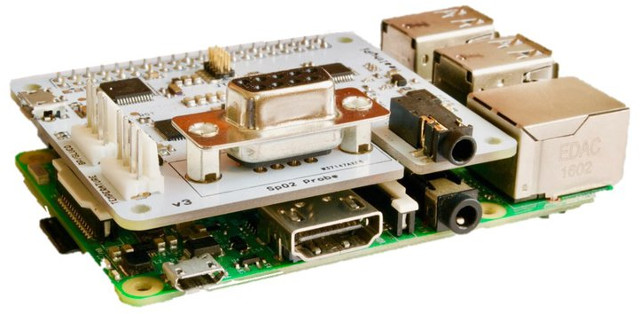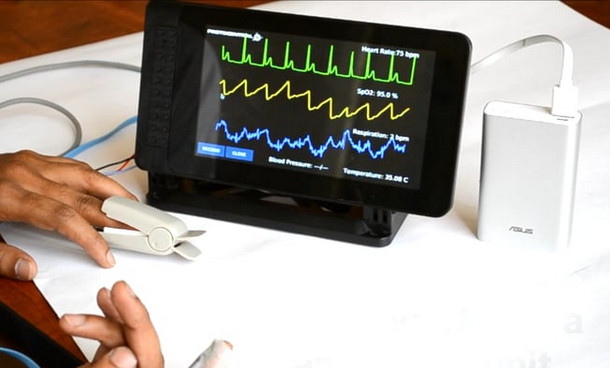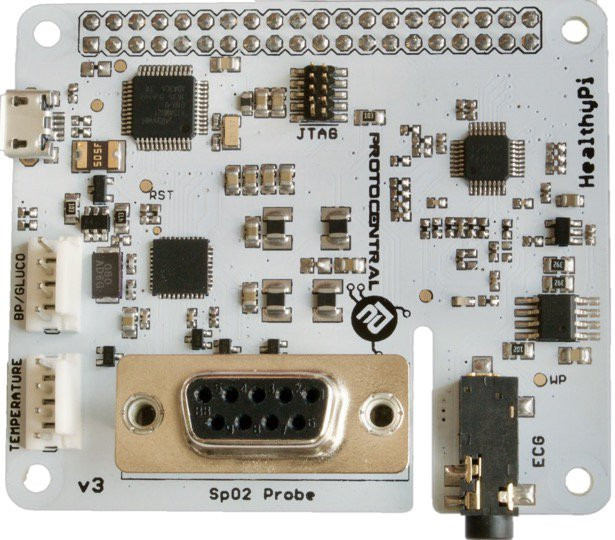Bangalore based ProtonCentral has launched the third version of Healthy Pi, a vital sign monitor using the Raspberry Pi as its computing and display platform, and capable of measuring body temperature, oxygen saturation, and ECG/respiratory data.
 Healthy Piv3 board specifications:
Healthy Piv3 board specifications:
- MCU – Atmel ATSAMD21 ARM Cortex M0 MCU, compatible with Arduino Zero
- Vital Signs Chips
- ECG and respiration front-end – TI ADS1292R 24-bit analog front-end with SNR of 107 dB
- Pulse oximetry – TI AFE4490 Pulse Oximetry front-end with integrated LED driver and 22-bit ADC
- Temperature – Maxim MAX30205 digital body temperature sensor for skin temperature sensing
- Expansions Headers and Ports
- 1x 40-pin header to connect to Raspberry Pi
- 2x 3-pin connectors for temperature and BP/GLUCO
- DB9 connector for finger-clip Spo2 probe
- 3.5mm jack for ECG cable and probes
- 1x UART connector for an external blood pressure module
- USB – 1x micro USB port for power and programming
- Debugging – 10-pin JTAG header
- Dimensions – 65 mm x 56.5 mm x 6 mm (Raspberry Pi HAT form factor)
- Weight – 100 g
The board comes with Arduino Zero bootloader, can be programmed with the Arduino IDE or Atmel Studio, and is usable as a standalone board. However, connecting it to a Raspberry Pi 3 board will allow you to leverage WiFi connectivity to communication with a TCP client for telemedicine applications, or using an MQTT client for continuous logging applications for example sending data to an AWS EC2 instance running Thingsboard IoT platform, as well as running Java based HealthyPi GUI on a display. The board is not fully open source hardware, as gerber files and BoM are missing, but they’ve released PDF and EAGLE schematics and PCB layout, as well as GUI and firmware source code on github.
 The company launched the board on Crowdsupply, where they have raised over $10,000 dollars so far. There are two main options:
The company launched the board on Crowdsupply, where they have raised over $10,000 dollars so far. There are two main options:
- $195 Healthy Pi 3 HAT Kit with HealthyPi v3 board, 3-electrode cable with “button” connectors on one end and stereo connector on the other end, Finger-clip Spo2 probe, digital skin temperature sensor, 20 single-use disposable ECG electrodes, and a HAT mounting kit
- $369 (Early bird)/ $395 Healthy Pi 3 Complete Kit with the content of Healthy Pi 3 HAT Kit plus a Raspberry Pi 3 board, a 16GB microSD card with pre-loaded Raspbian and Healthy Pi software, a 7” touchscreen LCD, SmartiPi Touch enclosure for display and Pi, a 5 V/2.5 A medical-grade power adapter with a country-specific snap-on plug
While they provide a 5V/2.5A power bank, they recommend to use a power bank for safety reasons, and to minimizes noise. If you use the board in standalone connected to a laptop, it is also recommended to run on battery during measurements for extra safety.
Delivery is scheduled for July 10, 2017, and free worldwide shipping is included in the prices above. The system will eventually be sold on ProtoCentral website too.

Jean-Luc started CNX Software in 2010 as a part-time endeavor, before quitting his job as a software engineering manager, and starting to write daily news, and reviews full time later in 2011.
Support CNX Software! Donate via cryptocurrencies, become a Patron on Patreon, or purchase goods on Amazon or Aliexpress





